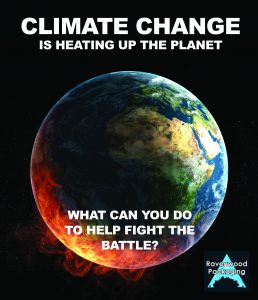Climate change is happening, and the devastating effects are all too apparent.
As we know, plastic especially where packaging is concerned, is a big problem for the environment, even before it pollutes our rivers and oceans. Plastic is a major contributor to climate change. That’s because chemicals derived from fossil fuel production are used to make almost all plastics – more than 99% of them. So the more plastic we make, the more of these petrochemicals we need. And the more petrochemicals we need, the higher the demand for gas, oil and even coal. The same fuels driving dangerous climate change.
Ravenwood, as a packaging and labelling specialist, has over the years, learnt much on this subject. But climate change doesn’t just end at problems with plastic and packaging, so we feel we must cast our eye away to see what we as individuals can do to help combat climate change for a better tomorrow.
While there are many ways to do this and save energy; such as insulating our homes, putting up solar panels, and planting trees, the following are the simplest and easiest changes you can make, with little effort or financial outlay.
TO BEGIN: Calculate your carbon footprint
Your carbon footprint is the amount of greenhouse gases, including carbon dioxide, methane, nitrous oxide, fluorinated gases and others, that you produce as you live your life, as an individual. The Paris Climate Conference determined that in order for life to exist on this planet, a global temperature rise to 2˚C must not be breached. The Earth has already warmed 1 degree Celsius (1.8 degrees Fahrenheit) since the 19th century. Half a degree may not sound like much but even that much warming could expose tens of millions more people worldwide to life-threatening heat waves, water shortages and coastal flooding. Half a degree may mean the difference between a world with coral reefs and Arctic summer sea ice and a world without them.
Calculate your carbon footprint at carbonfootprint.com to find out how green your foot is.
So now you have your footprint, here are some of the easiest ways in which you can start to reduce the size of yours:
FOOD
‘Veg out’
All the evidence now points in one direction – shifting from a meat based, to a plant based diet. A paper published in Science reveals that while some kinds of meat and dairy products are more damaging than others, all are more harmful to the living world when comparing to plant protein. Animal farming takes up 83% of the world’s agricultural land, but delivers only 18% of our calories. A plant based diet cuts the land by 76% and halves the greenhouse gases. You can start by joining Meatless Mondays.
Go organic and stay local
Stick to foods that are in season. Focus on the ‘field to fork’. Transporting food from far away, whether by truck, ship, rail or plane, uses fossil fuels for fuel and for cooling to keep foods in transit from spoiling. Eating locally grown food will also help support the community.
Buy in bulk
When and where possible, when supermarkets have special offers. Freeze and eat another day. You’ll save money too.
Waste not want not
Plan meals ahead. Freezing the excess and reusing leftovers will also be kinder on your pocket. In total, around 3.1 million tonnes of food waste occurred in the entire supply chain in 2015.
Get on top of your compost
Reduce your food waste. Create your very own compost heap at home.
Stop buying items in throw-away packaging
The general guideline for minimising our throw-away society is for a more eco-friendly approach to buying products. Aim for the least possible packaging or products with recyclable packaging. Shop at stores that sell loose items and who will let you use your own refillable containers.
CLOTHING
Don’t be a slave to fashion
With fashion comes cheaply made and ‘on-trend’ items that go out of style quickly and get dumped in landfills, where they produce methane as they decompose. The value of unused clothing in wardrobes has been estimated at around £30 billion. It is also estimated £140 million worth of clothing goes into landfill each year. In addition, most fast fashion comes from China and Bangladesh, so shipping it around the world requires the use of fossil fuels. Instead, buy quality clothing that will last or even better, buy vintage or recycled clothing on sites such a eBay or your local charity shop.
Wash your clothing in cold water
The enzymes in cold water detergent are designed to clean better in cold water. About 90% of the energy the washing machine uses goes towards heating the water. Washing in cold saves energy, is kinder to your clothes and will help save the planet.
HOME
Switch to LED light bulbs
Incandescent bulbs waste 90% of their energy as heat. These bulbs have filaments that glow, producing both heat and light when energy flows through them. LED’s, on the other hand, have electrons that flow to create photons – light we can see. Photons generate almost no heat. Though LEDs cost more, they use a quarter of the energy and last up to 25 times longer.
Switch lights off
Turn your lights off when you leave the room and unplug your electronic devices, when they are not in use.
Turn your water heater down
Turning down to 120˚F can save about 550 pounds of CO2 a year.
Clean up your act
Source your electricity from a green energy company through your local utility or a certified renewable energy provider. Conscious Creatives has recently released a list of the top 5 providers in the UK.
TRANSPORTATION
Drive less
Walk, take public transportation, rideshare or bike to your destination when possible. This not only reduces CO2 emissions, but it also lessens traffic congestion.
Drive carefully
If you must drive, avoid unnecessary braking and acceleration. Some studies have found that aggressive driving can result in 40% more fuel consumption than consistent, calm driving. You’ll also feel more relaxed when you arrive at your destination.
Take care of your car
Under-inflated tyres are dangerous and can also increase fuel waste. Making sure that your tyres are in good shape, as well as being properly inflated, will keep you safer and will increase your fuel efficiency.
Use traffic apps
Apps such as Waze can help you avoid getting stuck in traffic jams and save on journey time.
Turn on the cruise control
If you have a long journey ahead of you, it pays to switch on the cruise control for saving on fuel.
Choose wisely when buying a new car
If you’re shopping for a new car, consider purchasing a hybrid or electric vehicle. But do factor in the greenhouse gas emissions from the production of the car as well as its operation. Some electric vehicles are initially responsible for more emissions than internal combustion engine vehicles because of manufacturing impacts; but they make up for it after three years.
So there you have it. Our round up of how you can personally fight the battle against climate change and reduce related CO2 emissions. As the saying goes: “Small steps equal big change.”
Author: Natalie Bell (Marketing & Events Manager)

